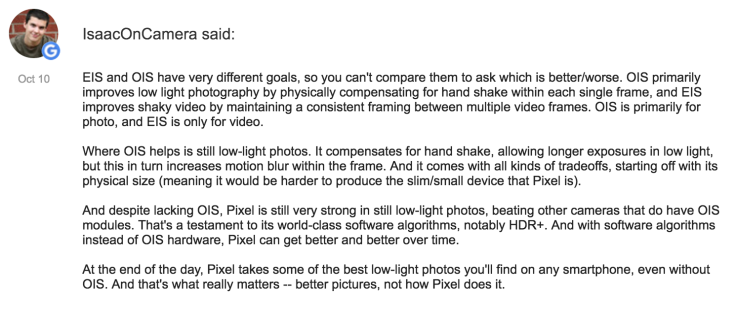Google Employee Explains The Absence Of OIS On Pixel Smartphone Cameras
When Google introduced the Pixel and Pixel XL smartphones, the company said that both handsets have the “best smartphones cameras ever” earning a DxOMark score of 89. However, many are pointing out the cameras’ lack of optical image stabilization for video recording and this has prompted Google to address the issue.
The Pixel and Pixel XL both come with a 12.3-megapixel rear camera that comes with Sony’s IMX378 sensor. The cameras on both phones have an f/2.0 lens, while the sensor itself is 1.55-micron pixels large, which is bigger than most of its rivals, according to Android Headlines. This allows the Pixels to capture more light in less time producing better exposed images even in low light.
That’s all great for taking photos, and Google has already published beautiful photos captured with the Pixel smartphones to prove its superior performance. However, when it comes to video recording, the absence of optical image stabilization (OIS) is simply mind-boggling for many.
Most of today’s flagship smartphone cameras feature OIS, a technology that mechanically stabilizes videos by moving around the lens inside a smartphone. For Google’s Pixel and Pixel XL, the handsets feature electronic image stabilization (EIS).
One user went to the Google Product Forums to ask why the Pixel smartphones are using EIS instead of OIS. Luckily, a member of Google's camera team, Isaac Reynolds (IsaacOnCamera), explained the reason for the choice in camera technology.
“EIS and OIS have very different goals, so you can’t compare them to ask which is better/worse,” Reynolds wrote. “OIS primarily improves low light photography by physically compensating for hand shake within each single frame, and EIS improves shaky video by maintaining a consistent framing between multiple video frames. OIS is primarily for photo, and EIS is only for video.”

Reynolds further explained that OIS also has some tradeoffs. One in particular is its physical size. Adopting EIS eliminates the need for a camera bump on the back of the Pixel handsets. OIS does allow more time for light to enter the sensor, but it also increases the chances of motion blur as well.
Reynolds also noted that the Pixel still beats its rivals that have OIS tech thanks to its software algorithms. The use of software also means that camera performance on the Pixel smartphones can also improve over time with updates — something that’s impossible with OIS.
Google’s Nexus 6P from last year also utilized EIS technology for its camera. It provided EIS for recording 720p and 1080p videos, but not for 4K. For the Pixel and Pixel XL, Reynolds confirmed that 4K video recording will fully support EIS technology.
© Copyright IBTimes 2024. All rights reserved.











